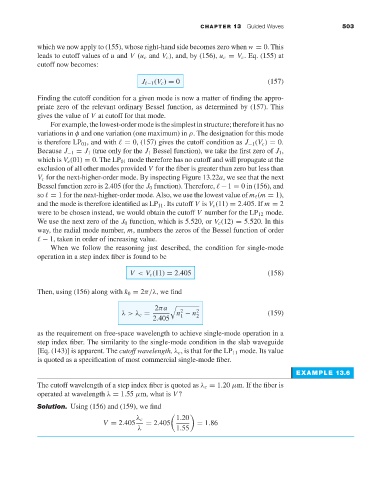Page 521 - Engineering Electromagnetics, 8th Edition
P. 521
CHAPTER 13 Guided Waves 503
which we now apply to (155), whose right-hand side becomes zero when w = 0. This
leads to cutoff values of u and V (u c and V c ), and, by (156), u c = V c . Eq. (155) at
cutoff now becomes:
J −1 (V c ) = 0 (157)
Finding the cutoff condition for a given mode is now a matter of finding the appro-
priate zero of the relevant ordinary Bessel function, as determined by (157). This
gives the value of V at cutoff for that mode.
Forexample, the lowest-order mode is the simplest in structure; therefore it has no
variations in φ and one variation (one maximum) in ρ. The designation for this mode
is therefore LP 01 , and with = 0, (157) gives the cutoff condition as J −1 (V c ) = 0.
Because J −1 = J 1 (true only for the J 1 Bessel function), we take the first zero of J 1 ,
which is V c (01) = 0. The LP 01 mode therefore has no cutoff and will propagate at the
exclusion of all other modes provided V for the fiber is greater than zero but less than
V c for the next-higher-order mode. By inspecting Figure 13.22a,we see that the next
Bessel function zero is 2.405 (for the J 0 function). Therefore, −1 = 0in (156), and
so = 1 for the next-higher-order mode. Also, we use the lowest value of m (m = 1),
and the mode is therefore identified as LP 11 . Its cutoff V is V c (11) = 2.405. If m = 2
were to be chosen instead, we would obtain the cutoff V number for the LP 12 mode.
We use the next zero of the J 0 function, which is 5.520, or V c (12) = 5.520. In this
way, the radial mode number, m, numbers the zeros of the Bessel function of order
− 1, taken in order of increasing value.
When we follow the reasoning just described, the condition for single-mode
operation in a step index fiber is found to be
V < V c (11) = 2.405 (158)
Then, using (156) along with k 0 = 2π/λ,wefind
2πa
2
λ>λ c = n − n 2 (159)
2.405 1 2
as the requirement on free-space wavelength to achieve single-mode operation in a
step index fiber. The similarity to the single-mode condition in the slab waveguide
[Eq. (143)] is apparent. The cutoff wavelength, λ c ,is that for the LP 11 mode. Its value
is quoted as a specification of most commercial single-mode fiber.
EXAMPLE 13.6
The cutoff wavelength of a step index fiber is quoted as λ c = 1.20 µm. If the fiber is
operated at wavelength λ = 1.55 µm, what is V ?
Solution. Using (156) and (159), we find
λ c 1.20
V = 2.405 = 2.405 = 1.86
λ 1.55

